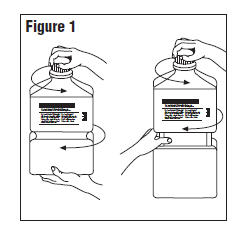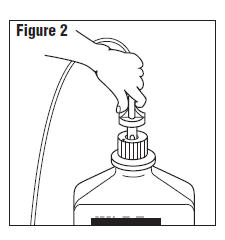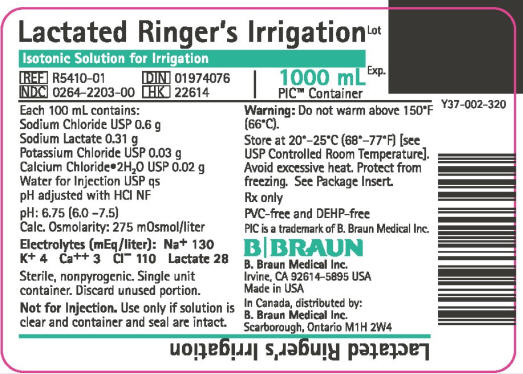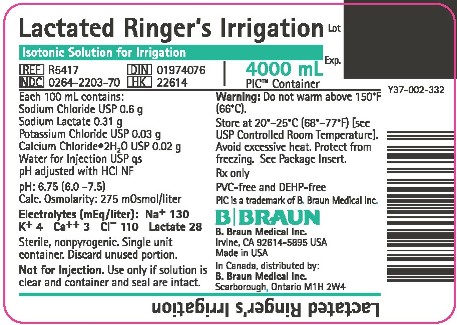LACTATED RINGERS- sodium chloride, sodium lactate, potassium chloride, and calcium chloride irrigant
Lactated Ringers by
Drug Labeling and Warnings
Lactated Ringers by is a Prescription medication manufactured, distributed, or labeled by B. Braun Medical Inc.. Drug facts, warnings, and ingredients follow.
Drug Details [pdf]
- SPL UNCLASSIFIED SECTION
-
DESCRIPTION
Lactated Ringer's Irrigation is a sterile, nonpyrogenic, solution of electrolytes in water for injection intended only for sterile irrigation, washing and rinsing purposes. The composition is based on a modification of the injectable formula originally known as Hartmann's Solution.
Each 100 mL contains:
Sodium Chloride USP 0.6 g, Sodium Lactate 0.31 g, Potassium Chloride USP 0.03 g, Calcium Chloride Dihydrate USP 0.02 g, Water for Injection USP qs.pH adjusted with Hydrochloric Acid NF
pH: 6.75 (6.0–7.5) Calculated Osmolarity: 275 mOsmol/literConcentration of Electrolytes (mEq/liter): Sodium 130, Potassium 4, Calcium 3, Chloride 110, Lactate (CH3CH(OH)COO−) 28
The solution contains no bacteriostat, antimicrobial agent or added buffer (except for pH adjustment) and is intended only for use as a single-dose or short procedure irrigation. When smaller volumes are required the unused portions should be discarded. Lactated Ringer's Irrigation may be classified as a sterile irrigant, wash, rinse and pharmaceutical vehicle.
The formulas of the active ingredients are:
Ingredients Molecular Formula Molecular Weight Sodium Chloride USP NaCl 58.44 Sodium Lactate CH3CH(OH)COONa 112.06 Potassium Chloride USP KCl 74.55 Calcium Chloride Dihydrate USP CaCl22H2O 147.01 The plastic container is a copolymer of ethylene and propylene formulated and developed for parenteral drugs. The copolymer contains no plasticizers and exhibits virtually no leachability. The plastic container is also virtually impermeable to vapor transmission and therefore, requires no overwrap to maintain the proper drug concentration. The safety of the plastic container has been confirmed by biological evaluation procedures. The material passes Class Vl testing as specified in the U.S. Pharmacopeia for Biological Tests — Plastic Containers. These tests have shown that the container is nontoxic and biologically inert.
The PIC™ Container is PVC-free and DEHP-free.
-
CLINICAL PHARMACOLOGY
Lactated Ringer's Irrigation exerts a mechanical cleansing action for sterile irrigation of body cavities, tissues or wounds, indwelling urethral catheters and surgical drainage tubes, and for washing, rinsing or soaking surgical dressings, instruments and laboratory specimens. It also serves as a vehicle for drugs used for irrigation or other pharmaceutical preparations.
Lactated Ringer's Irrigation provides an isotonic irrigation with the same ionic constituents as Lactated Ringer's Injection, USP, a modification of Hartmann's Solution.Lactated Ringer's Irrigation is considered generally compatible with living tissues and organs.
Calcium chloride in water dissociates to provide calcium (Ca++) and chloride (Cl−) ions. They are normal constituents of the body fluids and are dependent on various physiologic mechanisms for maintenance of balance between intake and output. Approximately 80% of body calcium is excreted in the feces as insoluble salts; urinary excretion accounts for the remaining 20%.
Potassium chloride in water dissociates to provide potassium (K+) and chloride (Cl−) ions. Potassium is the chief cation of body cells (160 mEq/liter of intracellular water). It is found in low concentration in plasma and extracellular fluids (3.5 to 5 mEq/liter in a healthy adult). Potassium plays an important role in electrolyte balance.
Normally about 80 to 90% of the potassium intake is excreted in the urine; the remainder in the stools and to a small extent, in the perspiration. The kidney does not conserve potassium well so that during fasting or in patients on a potassium-free diet, potassium loss from the body continues resulting in potassium depletion.
Sodium chloride in water dissociates to provide sodium (Na+) and chloride (Cl−) ions. Sodium (Na+) is the principal cation of the extracellular fluid and plays a large part in the therapy of fluid and electrolyte disturbances. Chloride (Cl−) has an integral role in buffering action when oxygen and carbon dioxide exchange occurs in the red blood cells. The distribution and excretion of sodium (Na+) and chloride (Cl−) are largely under the control of the kidney which maintains a balance between intake and output.
Sodium lactate in water dissociates to provide sodium (Na+) and lactate (C3H5O−3) ions. The lactate anion provides an alkalizing effect resulting from simultaneous removal by the liver of lactate and hydrogen ions. In the liver, the lactate is metabolized to glycogen which is ultimately converted to carbon dioxide and water by oxidative metabolism.
The lactate anion acts as a source (alternate) of bicarbonate when normal production and utilization of lactic acid is not impaired as a result of disordered lactate metabolism. Since metabolic conversion is dependent on the integrity of cellular oxidative processes, lactate may be inadequate or ineffective as a source of bicarbonate in patients suffering from acidosis associated with shock or other disorders involving reduced perfusion of body tissues. When oxidative activity is intact, one to two hours time is required for metabolism of lactate.
Water is an essential constituent of all body tissues and accounts for approximately 70% of total body weight. Average normal adult daily requirement ranges from two to three liters (1 to 1.5 liters each for insensible water loss by perspiration and urine production).
Water balance is maintained by various regulatory mechanisms. Water distribution depends primarily on the concentration of electrolytes in the body compartments and sodium (Na+) plays a major role in maintaining physiologic equilibrium.
- INDICATIONS AND USAGE
- CONTRAINDICATIONS
-
WARNINGS
FOR IRRIGATION ONLY. NOT FOR INJECTION.
Irrigating fluids have been demonstrated to enter the systemic circulation in relatively large volumes; thus this irrigation must be regarded as a systemic drug. Absorption of large amounts can cause fluid and/or solute overloading resulting in dilution of serum electrolyte concentrations, overhydration, congested states or pulmonary edema.
The risk of dilutional states is inversely proportional to the electrolyte concentrations of administered parenteral solutions. The risk of solute overload causing congested states with peripheral and pulmonary edema is directly proportional to the electrolyte concentrations of such solutions.
Do not warm container over 150°F (66°C).
-
PRECAUTIONS
General
Do not use for irrigation that may result in absorption into the blood.
Caution should be observed when the solution is used for continuous irrigation or allowed to "dwell" inside body cavities because of possible absorption into the blood stream and the production of circulatory overload.
Aseptic technique is essential with the use of sterile solutions for irrigation of body cavities, wounds and urethral catheters or for wetting dressings that come in contact with body tissues.
When used as a "pour" irrigation, no part of the contents should be allowed to contact the surface below the outer protected thread area of the plastic irrigation container. When used for irrigation via irrigation equipment, the administration set should be attached promptly. Unused portions should be discarded and a fresh container of appropriate size used for the start-up of each cycle or repeat procedure. For repeated irrigations of urethral catheters, a separate container should be used for each patient
Use only if solution is clear and container and seal are intact.
-
ADVERSE REACTIONS
Possible adverse effects arising from the irrigation of body cavities, tissues, or indwelling catheters and tubes are usually avoidable when proper procedures are followed. Displaced catheters or drainage tubes can lead to irrigation or infiltration of unintended structures or cavities. Excessive volume or pressure during irrigation of closed cavities may cause undue distension or disruption of tissues. Accidental contamination from careless technique may transmit infection.
Should any adverse reaction occur, discontinue the irrigant, evaluate the patient, institute appropriate therapeutic countermeasures and save the remainder of the fluid for examination if deemed necessary.
-
OVERDOSAGE
In the event of overhydration or solute overload, re-evaluate the patient and institute appropriate corrective measures. See WARNINGS, PRECAUTIONS and ADVERSE REACTIONS.
-
DOSAGE AND ADMINISTRATION
The dose is dependent upon the capacity or surface area of the structure to be irrigated and the nature of the procedure. When used as a vehicle for other drugs, the manufacturer's recommendations should be followed.
Drug Interactions
Additives may be incompatible. Consult with pharmacist, if available. When introducing additives, use aseptic technique, mix thoroughly and do not store.
Parenteral drug products should be inspected visually for particulate matter and discoloration prior to administration, whenever solution container permits. See PRECAUTIONS.
-
HOW SUPPLIED
Lactated Ringer's Irrigation is supplied sterile and nonpyrogenic in PIC™ (Plastic Irrigation Container). The 1000 mL containers are packaged 16 per case, the 2000 mL containers are packaged 8 per case, and the 4000 mL containers are packaged 4 per case.
NDC Cat. No. Size Lactated Ringer's Irrigation
(Canada DIN 01974076)0264-2203-00 R5410-01 1000 mL 0264-2203-50 R5415-01 2000 mL 0264-2203-70 R5417 4000 mL - SPL UNCLASSIFIED SECTION
-
Directions for Use of PIC™ (Plastic Irrigation Container)
Not for injection.
Aseptic technique is required.
-
Caution – Before use, perform the following checks:
- (a) Read the label. Ensure solution is the one ordered and is within the expiration date.
- (b) Invert container and inspect the solution in good light for cloudiness, haze, or particulate matter; check the container for leakage or damage. Any container which is suspect should not be used.
- Use only if solution is clear and container and seal are intact.
- Single unit container. Discard unused portion.
- Outer Closure Removal – Grasp the container with one hand and turn the breakaway ring counterclockwise with the other hand until slight resistance is felt. Then, twisting the container in the opposite direction, turn the breakaway ring sharply until the entire outer cap is loose and can be lifted off. (Figure 1)

- Connect the administration set through the sterile set port according to set instructions (Figure 2) or remove screw cap and pour.

- Do not warm above 150°F (66°C) to assure minimal bottle distortion. Keep bottles upright.
-
- SPL UNCLASSIFIED SECTION
-
PRINCIPAL DISPLAY PANEL - 1000 mL Label
Lactated Ringer's Irrigation
Isotonic Solution for Irrigation
REF R5410-01 DIN 01974076 NDC: 0264-2203-00 HK 22614 1000 mL
PIC™ ContainerLot
Exp.
Each 100 mL contains:
Sodium Chloride USP 0.6 g
Sodium Lactate 0.31 g
Potassium Chloride USP 0.03 g
Calcium Chloride2H2O USP 0.02 g
Water for Injection USP qs
pH adjusted with HCl NFpH: 6.75 (6.0 – 7.5)
Calc. Osmolarity: 275 mOsmol/literElectrolytes (mEq/liter): Na+ 130
K+ 4 Ca++ 3 Cl− 110 Lactate 28Sterile, nonpyrogenic. Single unit
container. Discard unused portion.Not for Injection. Use only if solution is
clear and container and seal are intact.Warning: Do not warm above 150°F
(66°C).Store at 20°–25°C (68°–77°F) [see
USP Controlled Room Temperature].
Avoid excessive heat. Protect from
freezing. See Package Insert.Rx only
PVC-free and DEHP-free
PIC is a trademark of B. Braun Medical Inc.
B|BRAUN
B. Braun Medical Inc.
Irvine, CA 92614-5895 USA
Made in USAIn Canada, distributed by:
B. Braun Medical Inc.
Scarborough, Ontario M1H 2W4Y37-002-320

-
PRINCIPAL DISPLAY PANEL - 2000 mL Label
Lactated Ringer's Irrigation
Isotonic Solution for Irrigation
REF R5415-01 DIN 01974076 NDC: 0264-2203-50 HK 22614 2000 mL
PIC™ ContainerLot
Exp.
Each 100 mL contains:
Sodium Chloride USP 0.6 g
Sodium Lactate 0.31 g
Potassium Chloride USP 0.03 g
Calcium Chloride2H2O USP 0.02 g
Water for Injection USP qs
pH adjusted with HCl NFpH: 6.75 (6.0 – 7.5)
Calc. Osmolarity: 275 mOsmol/literElectrolytes (mEq/liter): Na+ 130
K+ 4 Ca++ 3 Cl− 110 Lactate 28Sterile, nonpyrogenic. Single unit
container. Discard unused portion.Not for Injection. Use only if solution is
clear and container and seal are intact.Warning: Do not warm above 150°F
(66°C).Store at 20°–25°C (68°–77°F) [see
USP Controlled Room Temperature].
Avoid excessive heat. Protect from
freezing. See Package Insert.Rx only
PVC-free and DEHP-free
PIC is a trademark of B. Braun Medical Inc.
B. Braun Medical Inc.
Irvine, CA 92614-5895 USA
Made in USAIn Canada, distributed by:
B. Braun Medical Inc.
Scarborough, Ontario M1H 2W4Y37-002-331

-
PRINCIPAL DISPLAY PANEL - 4000 mL Label
Lactated Ringer's Irrigation
Isotonic Solution for Irrigation
REF R5417 DIN 01974076 NDC: 0264-2203-70 HK 22614 4000 mL
PIC™ ContainerLot
Exp.
Each 100 mL contains:
Sodium Chloride USP 0.6 g
Sodium Lactate 0.31 g
Potassium Chloride USP 0.03 g
Calcium Chloride2H2O USP 0.02 g
Water for Injection USP qs
pH adjusted with HCl NFpH: 6.75 (6.0 – 7.5)
Calc. Osmolarity: 275 mOsmol/literElectrolytes (mEq/liter): Na+ 130
K+ 4 Ca++ 3 Cl− 110 Lactate 28Sterile, nonpyrogenic. Single unit
container. Discard unused portion.Not for Injection. Use only if solution is
clear and container and seal are intact.Warning: Do not warm above 150°F
(66°C).Store at 20°–25°C (68°–77°F) [see
USP Controlled Room Temperature].
Avoid excessive heat. Protect from
freezing. See Package Insert.Rx only
PVC-free and DEHP-free
PIC is a trademark of B. Braun Medical Inc.
B. Braun Medical Inc.
Irvine, CA 92614-5895 USA
Made in USAIn Canada, distributed by:
B. Braun Medical Inc.
Scarborough, Ontario M1H 2W4Y37-002-332

-
INGREDIENTS AND APPEARANCE
LACTATED RINGERS
sodium chloride, sodium lactate, potassium chloride, and calcium chloride irrigantProduct Information Product Type HUMAN PRESCRIPTION DRUG Item Code (Source) NDC: 0264-2203 Route of Administration IRRIGATION Active Ingredient/Active Moiety Ingredient Name Basis of Strength Strength SODIUM CHLORIDE (UNII: 451W47IQ8X) (SODIUM CATION - UNII:LYR4M0NH37, CHLORIDE ION - UNII:Q32ZN48698) SODIUM CHLORIDE 0.6 g in 100 mL SODIUM LACTATE (UNII: TU7HW0W0QT) (SODIUM CATION - UNII:LYR4M0NH37, LACTIC ACID - UNII:33X04XA5AT) SODIUM LACTATE 0.31 g in 100 mL POTASSIUM CHLORIDE (UNII: 660YQ98I10) (POTASSIUM CATION - UNII:295O53K152, CHLORIDE ION - UNII:Q32ZN48698) POTASSIUM CHLORIDE 0.03 g in 100 mL CALCIUM CHLORIDE (UNII: M4I0D6VV5M) (CALCIUM CATION - UNII:2M83C4R6ZB, CHLORIDE ION - UNII:Q32ZN48698) CALCIUM CHLORIDE 0.02 g in 100 mL Inactive Ingredients Ingredient Name Strength WATER (UNII: 059QF0KO0R) Packaging # Item Code Package Description Marketing Start Date Marketing End Date 1 NDC: 0264-2203-00 16 in 1 CASE 12/27/1982 1 1000 mL in 1 CONTAINER; Type 0: Not a Combination Product 2 NDC: 0264-2203-50 8 in 1 CASE 12/27/1982 2 2000 mL in 1 CONTAINER; Type 0: Not a Combination Product 3 NDC: 0264-2203-70 4 in 1 CASE 12/27/1982 3 4000 mL in 1 CONTAINER; Type 0: Not a Combination Product Marketing Information Marketing Category Application Number or Monograph Citation Marketing Start Date Marketing End Date NDA NDA018681 12/27/1982 Labeler - B. Braun Medical Inc. (002397347)
© 2025 FDA.report
This site is not affiliated with or endorsed by the FDA.